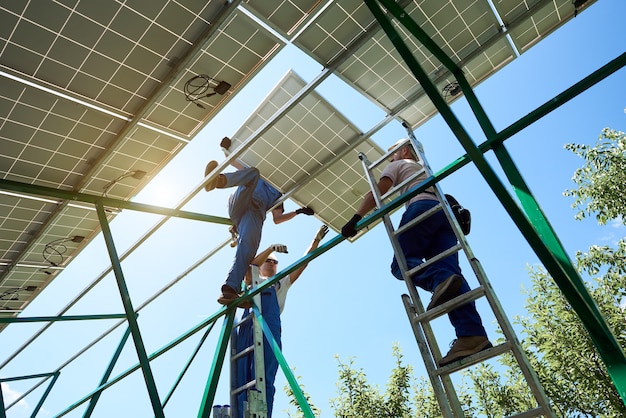Federal Support for Green Jobs: New Opportunities in Renewable Energy

Federal support for green jobs is expanding opportunities in the renewable energy sector through policy initiatives, funding, and training programs aimed at fostering economic growth and environmental sustainability in the US.
The landscape of renewable energy in the United States is undergoing a significant transformation, largely fueled by federal support for green jobs: exploring new opportunities in the renewable energy sector. These initiatives are not just about environmental conservation; they are increasingly recognized as pivotal for economic growth, job creation, and technological advancement.
Understanding Federal Initiatives for Green Jobs
Federal initiatives play a crucial role in shaping the green job market. These initiatives often manifest as policy changes, financial incentives, and collaborative programs designed to stimulate growth in the renewable energy sector and support the development of a skilled workforce.
Key Federal Policies Supporting Green Jobs
Several federal policies have been instrumental in driving the growth of green jobs. These policies aim to reduce carbon emissions, promote energy efficiency, and encourage the adoption of renewable energy technologies.
- The Inflation Reduction Act: A landmark bill that includes significant investments in clean energy and climate resilience, providing tax credits and incentives for renewable energy projects.
- Bipartisan Infrastructure Law: Allocates billions of dollars to upgrade the nation’s infrastructure, including investments in electric vehicle charging stations and grid modernization.
- The Energy Act of 2020: Focuses on energy efficiency, renewable energy, and advanced energy technologies, supporting research, development, and deployment programs.
These policies collectively enhance the economic viability of green industries, making them more competitive and attractive for investors, businesses, and job seekers.
Renewable Energy Sectors Benefiting from Federal Support
Federal support is not uniformly distributed across all sectors; rather, it targets areas where it can have the greatest impact. These sectors typically include solar, wind, geothermal, and hydropower.

Solar Energy
The solar energy sector, encompassing photovoltaic (PV) and concentrated solar power (CSP) technologies, has experienced substantial growth due to federal support. This growth is driven by tax incentives, grants, and loan programs that reduce the cost of solar energy systems.
Wind Energy
Wind energy has also been a significant beneficiary of federal support. Wind energy projects, both onshore and offshore, receive tax credits and other incentives that make them economically viable. These incentives encourage private investment and technological advancements.
Geothermal and Hydropower
Geothermal and hydropower, though often overlooked, also benefit from federal initiatives. Geothermal energy projects receive tax credits and loan guarantees, while hydropower projects benefit from funding for upgrades and new developments.
By strategically targeting these sectors, the federal government maximizes the economic and environmental benefits of its green job initiatives.
Job Creation and Economic Impact
The primary goal of federal support for green jobs is to stimulate job creation and foster economic growth. The renewable energy sector has demonstrated a considerable potential for job creation.
Direct and Indirect Job Creation
Federal support directly leads to the creation of jobs in the renewable energy sector. These jobs include manufacturing, installation, maintenance, and research positions. Additionally, there is a ripple effect that generates indirect jobs in related industries.
Consider the solar energy sector: every solar panel installed requires a team of technicians, engineers, and project managers. These teams need support from logistics providers, suppliers, and administrative staff. Every wind turbine project requires similar support. This creates a demand for a wide range of skills and expertise.
Economic Benefits and Growth
Beyond job creation, federal support for green jobs contributes to broader economic benefits. Increased investment in renewable energy reduces dependence on fossil fuels, stabilizes energy prices, and enhances energy security. Furthermore, the development of a strong renewable energy sector creates opportunities for innovation and technological leadership.
The Inflation Reduction Act alone is projected to create hundreds of thousands of jobs and inject billions of dollars into the economy. These investments also help revitalize communities that have historically relied on fossil fuel industries.
Workforce Development and Training Programs
To fully realize the potential of green jobs, it is essential to develop a skilled workforce. Federal initiatives often include workforce development and training programs designed to equip workers with the skills needed to succeed in the renewable energy sector.
Federal Investments in Training
Federal agencies, such as the Department of Energy and the Department of Labor, invest in training programs that provide workers with the skills needed to install, maintain, and repair renewable energy systems. These programs often partner with community colleges, vocational schools, and labor unions.
Skills Requirements for Green Jobs
Green jobs require a diverse set of skills, ranging from technical expertise to project management. Workers in the renewable energy sector need skills in engineering, electrical work, construction, and data analysis. There is also a growing demand for workers with skills in energy efficiency, smart grid technologies, and energy storage.
- Technical Skills: Proficiency in installing, maintaining, and repairing renewable energy systems.
- Engineering Skills: Knowledge of engineering principles and design concepts.
- Project Management: Ability to manage projects from inception to completion, ensuring they are on time and within budget.
By investing in workforce development programs, the federal government ensures that the renewable energy sector has access to a skilled workforce.
Challenges and Opportunities
While federal support for green jobs has been instrumental in driving growth in the renewable energy sector, there are also challenges and opportunities that need to be addressed.

Overcoming Barriers to Green Job Growth
One of the main challenges is the need for comprehensive and coordinated policy frameworks. While federal initiatives provide a foundation for green job growth, there is a need for greater coordination across different levels of government.
Another key factor is the need to ensure that green jobs are accessible to all workers, regardless of their background. This requires targeted outreach to underrepresented communities. There is also a need to address the skills gap by providing workers with the training and education they need to succeed in the renewable energy sector.
Future Opportunities for Green Jobs
Despite these challenges, the future looks bright for green jobs. As renewable energy technologies continue to improve and become more affordable, there will be a growing demand for workers in the sector.
The development of new technologies, such as advanced energy storage systems and smart grid technologies, will provide additional opportunities for job creation and economic growth. By continuing to invest in green jobs, the federal government can ensure that the United States remains a leader in the global clean energy economy.
Case Studies: Successful Green Job Initiatives
Examining successful green job initiatives provides valuable insights into the most effective strategies for fostering economic growth and environmental sustainability.
Examples of Impactful Programs
Several states and local governments have implemented successful green job initiatives that serve as models for other communities.
California’s Clean Energy Workforce Training Program is a comprehensive program that provides workers with the skills needed to succeed in the renewable energy sector. The program partners with community colleges, vocational schools, and labor unions to offer training in solar panel installation, wind turbine maintenance, and energy efficiency.
- California’s Clean Energy Workforce Training Program: Provides comprehensive training in solar panel installation, wind turbine maintenance, and energy efficiency.
- Massachusetts Clean Energy Center: Funds clean energy projects and workforce development programs, fostering innovation and job creation.
- New York’s Green Jobs Green New York Program: Offers low-cost financing and technical assistance for energy efficiency upgrades, creating jobs in the construction and energy sectors.
These initiatives offer valuable insights into the strategies that are most effective for fostering economic growth and environmental sustainability.
Conclusion
Federal support for green jobs plays a critical role in driving growth and innovation in the renewable energy sector. These initiatives are not just about environmental conservation; they are increasingly recognized as pivotal for economic growth, job creation, and technological advancement.
| Key Point | Brief Description |
|---|---|
| 🌱 Policy Support | Incentives for renewable energy growth. |
| 🔆 Job Creation | New jobs in solar, wind, and more. |
| 🛠️ Workforce Training | Programs for skilled green workforce. |
| ⚡Economic Growth | Stimulating the renewable energy economy. |
Frequently Asked Questions
▼
Green jobs are employment opportunities in sectors that contribute to environmental preservation, resource efficiency, and sustainable practices. They span various industries, including renewable energy, energy efficiency, and environmental conservation.
▼
Federal support drives the creation and growth of green jobs by providing funding for renewable energy projects, tax incentives for green businesses, and investments in workforce training programs that equip workers with essential skills.
▼
Sectors like solar, wind, geothermal, and hydropower receive considerable attention and funding due to their potential for large-scale, sustainable energy production. Federal initiatives aim to enhance their efficiency and cost-effectiveness.
▼
Green jobs require a diverse range of skills, including technical expertise in engineering, electrical work, and construction, as well as project management skills to oversee and implement renewable energy projects effectively.
▼
California’s Clean Energy Workforce Training Program and Massachusetts’ Clean Energy Center are examples of how states are investing in renewable energy projects and workforce development, fostering innovation and job creation in the sector.
Conclusion
In conclusion, federal support for green jobs: exploring new opportunities in the renewable energy sector represents a crucial investment in the future of the US economy and environment. By strategically targeting key sectors, investing in workforce development, and addressing the challenges that hinder growth, the federal government can unlock the full potential of green jobs. This, in turn, leads to a more sustainable, resilient, and prosperous future for all.
